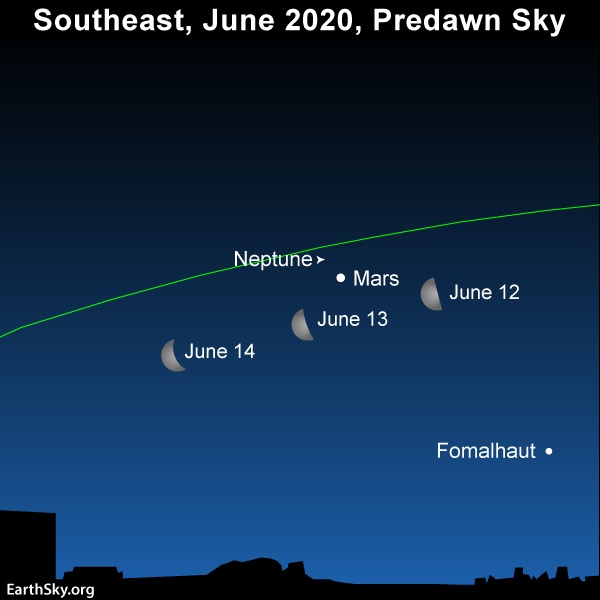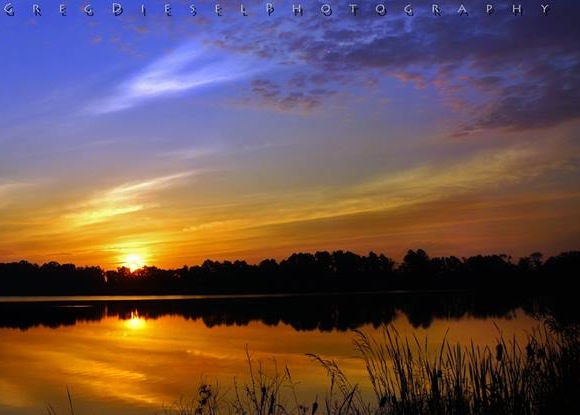
Top of post: June sunrise in Sea Bright, New Jersey, via Steve Scanlon Photography.
For the Northern Hemisphere: June is a super month for an early morning walk. The dawn light is beautiful at this time of year. At mid-northern latitudes in the Northern Hemisphere, your earliest sunrises of the year happen around now. That’s despite the fact that the northern summer solstice – and year’s longest day for this hemisphere – are still about a week away.
For the Southern Hemisphere: If you relish the daylight, as many do, you’ll be glad to know your sunsets will soon be shifting later! The earliest sunsets of the year are taking place around now for those at mid-latitudes in the Southern Hemisphere. That’s even though the winter solstice – the south’s shortest day – isn’t for another week.

At mid-northern latitudes, you’ll have to get up mighty early to catch the moon and the red planet Mars before sunrise this week! Read more.

Early sunrise in Sweden via Per Ola Wiberg.
The exact date of earliest sunrise (and earliest sunset) varies with latitude. At 40 degrees north latitude – the latitude of, say, Philadelphia in Pennsylvania – the earliest sunrise of the year will happen on June 14. For that same latitude, the latest sunset of the year will fall on or near June 27. Meanwhile, the longest day of the year – the day containing the greatest amount of daylight, overall – comes on the solstice on June 20.
So it is for other Northern Hemisphere latitudes. The dates of earliest sunrise and latest sunset don’t coincide exactly with the solstice. Appreciably south of Philadelphia’s latitude, the earliest sunrise has already come and gone (in late May or early June) and the latest sunset occurs at a later date (sometimes as late as July). In Hawaii, for instance, the earliest sunrise precedes the June solstice by about two weeks, and the latest sunset comes about two weeks after. Farther north, the earliest sunrise and latest sunset happen closer to the June solstice. Check it out at your latitude, using links on our almanac page.
The earliest sunrises come before the summer solstice because the day is more than 24 hours long at this time of the year. In the Southern Hemisphere, the earliest sunsets of the year come before the winter solstice for the same reason.
Enjoying EarthSky so far? Sign up for our free daily newsletter today!

View larger. | June sunrise over Currituck, North Carolina. Image via Greg Diesel Walck – Lunar/Landscape Photographer.
In June, the day (as measured by successive returns of the midday sun) is nearly 1/4 minute longer than 24 hours. Hence, the midday sun (solar noon) comes later by the clock on the June solstice than it does one week before. Therefore, the sunrise and sunset times also come later by the clock, as the tables below help to explain.
For Philadelphia (40 degrees north latitude)
| Date | Sunrise | Midday (Solar Noon) | Sunset | Daylight Hours |
| June 13 | 5:31 a.m. | 1:00 p.m. | 8:30 p.m. | 14h 59m 03s |
| June 20 | 5:32 a.m. | 1:02 p.m. | 8:32 p.m. | 15h 00m 36s |
For Valdivia, Chile (40 degrees south latitude)
| Date | Sunrise | Midday (Solar Noon) | Sunset | Daylight Hours |
| June 13 | 8:12 a.m. | 12:53 p.m. | 5:34 p.m. | 9h 22m 07s |
| June 20 | 8:14 a.m. | 12:54 p.m. | 5:35 p.m. | 9h 20m 38s |
Source: timeanddate.com.
The primary reason for the earliest sunrise preceding the summer solstice (and the earliest sunset preceding the winter solstice) is the inclination of the Earth’s rotational axis. The earliest sunrise or sunset would take place before the solstice even if the Earth went around the sun in a circular orbit.
However, the Earth’s elliptical orbit does affect the severity of the phenomenon. At the June solstice, Earth in its orbit is rather close to aphelion – its farthest point from the sun – which lessens the effect. At the December solstice, Earth is rather close to perihelion – its closest point to the sun – which accentuates it.
At middle latitudes, the earliest sunrise/sunset comes about one week before the June summer/winter solstice, and the latest sunset/sunrise about one week after the June solstice.
Yet, at the other end of the year, at middle latitudes, the earliest sunset/sunrise comes about two weeks before the December winter/summer solstice, and the latest sunrise/sunset about two weeks after the December solstice.

Early sunrise by Flickr user Rafal Zieba.
Bottom line: Are you an early riser? If so – if you live in the Northern Hemisphere – you might know your earliest sunrises of the year are happening now. Southern Hemisphere? Your earliest sunsets are around now.
EarthSky astronomy kits are perfect for beginners. Order today from the EarthSky store
Donate: Your support means the world to us
from EarthSky https://ift.tt/2MPxzUl

Top of post: June sunrise in Sea Bright, New Jersey, via Steve Scanlon Photography.
For the Northern Hemisphere: June is a super month for an early morning walk. The dawn light is beautiful at this time of year. At mid-northern latitudes in the Northern Hemisphere, your earliest sunrises of the year happen around now. That’s despite the fact that the northern summer solstice – and year’s longest day for this hemisphere – are still about a week away.
For the Southern Hemisphere: If you relish the daylight, as many do, you’ll be glad to know your sunsets will soon be shifting later! The earliest sunsets of the year are taking place around now for those at mid-latitudes in the Southern Hemisphere. That’s even though the winter solstice – the south’s shortest day – isn’t for another week.

At mid-northern latitudes, you’ll have to get up mighty early to catch the moon and the red planet Mars before sunrise this week! Read more.

Early sunrise in Sweden via Per Ola Wiberg.
The exact date of earliest sunrise (and earliest sunset) varies with latitude. At 40 degrees north latitude – the latitude of, say, Philadelphia in Pennsylvania – the earliest sunrise of the year will happen on June 14. For that same latitude, the latest sunset of the year will fall on or near June 27. Meanwhile, the longest day of the year – the day containing the greatest amount of daylight, overall – comes on the solstice on June 20.
So it is for other Northern Hemisphere latitudes. The dates of earliest sunrise and latest sunset don’t coincide exactly with the solstice. Appreciably south of Philadelphia’s latitude, the earliest sunrise has already come and gone (in late May or early June) and the latest sunset occurs at a later date (sometimes as late as July). In Hawaii, for instance, the earliest sunrise precedes the June solstice by about two weeks, and the latest sunset comes about two weeks after. Farther north, the earliest sunrise and latest sunset happen closer to the June solstice. Check it out at your latitude, using links on our almanac page.
The earliest sunrises come before the summer solstice because the day is more than 24 hours long at this time of the year. In the Southern Hemisphere, the earliest sunsets of the year come before the winter solstice for the same reason.
Enjoying EarthSky so far? Sign up for our free daily newsletter today!

View larger. | June sunrise over Currituck, North Carolina. Image via Greg Diesel Walck – Lunar/Landscape Photographer.
In June, the day (as measured by successive returns of the midday sun) is nearly 1/4 minute longer than 24 hours. Hence, the midday sun (solar noon) comes later by the clock on the June solstice than it does one week before. Therefore, the sunrise and sunset times also come later by the clock, as the tables below help to explain.
For Philadelphia (40 degrees north latitude)
| Date | Sunrise | Midday (Solar Noon) | Sunset | Daylight Hours |
| June 13 | 5:31 a.m. | 1:00 p.m. | 8:30 p.m. | 14h 59m 03s |
| June 20 | 5:32 a.m. | 1:02 p.m. | 8:32 p.m. | 15h 00m 36s |
For Valdivia, Chile (40 degrees south latitude)
| Date | Sunrise | Midday (Solar Noon) | Sunset | Daylight Hours |
| June 13 | 8:12 a.m. | 12:53 p.m. | 5:34 p.m. | 9h 22m 07s |
| June 20 | 8:14 a.m. | 12:54 p.m. | 5:35 p.m. | 9h 20m 38s |
Source: timeanddate.com.
The primary reason for the earliest sunrise preceding the summer solstice (and the earliest sunset preceding the winter solstice) is the inclination of the Earth’s rotational axis. The earliest sunrise or sunset would take place before the solstice even if the Earth went around the sun in a circular orbit.
However, the Earth’s elliptical orbit does affect the severity of the phenomenon. At the June solstice, Earth in its orbit is rather close to aphelion – its farthest point from the sun – which lessens the effect. At the December solstice, Earth is rather close to perihelion – its closest point to the sun – which accentuates it.
At middle latitudes, the earliest sunrise/sunset comes about one week before the June summer/winter solstice, and the latest sunset/sunrise about one week after the June solstice.
Yet, at the other end of the year, at middle latitudes, the earliest sunset/sunrise comes about two weeks before the December winter/summer solstice, and the latest sunrise/sunset about two weeks after the December solstice.

Early sunrise by Flickr user Rafal Zieba.
Bottom line: Are you an early riser? If so – if you live in the Northern Hemisphere – you might know your earliest sunrises of the year are happening now. Southern Hemisphere? Your earliest sunsets are around now.
EarthSky astronomy kits are perfect for beginners. Order today from the EarthSky store
Donate: Your support means the world to us
from EarthSky https://ift.tt/2MPxzUl

Aucun commentaire:
Enregistrer un commentaire